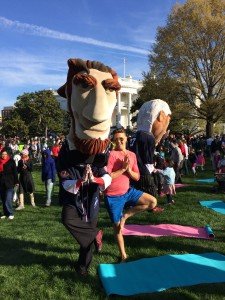Creating Safe Spaces for Practice
“Creating safe spaces isn’t about perfection – it’s about consistent commitment to embodying the respect we claim to value.”
Introduction: The Sacred Vulnerability of Practice
Every time someone steps on a yoga mat, they bring their entire being with them — heart, body, history, hope. And in the world of Ashtanga Yoga, with its intense repetition and often intimate shala environments, this vulnerability is amplified.
But let’s be honest — “safe space” is one of those buzzwords that can sound fabulous on a poster but fall flat on the floor next to your sweaty Manduka. The truth? Safety isn’t a marketing slogan. It’s a living, breathing system.
Creating truly safe practice spaces requires more than good vibes and “namaste” energy. It calls for embodied respect, clear boundaries, mutual accountability, and the courage to address discomfort without avoiding it.
Let’s explore what that really means — practically, relationally, and spiritually — in the context of Ashtanga Yoga.
I. The Foundation of Safety in Practice Spaces
Before anything else, we need to clarify: What do we mean by “safe”?
“Safety isn’t just physical – it’s emotional, intellectual, and energetic.”
Safety means you can show up as yourself — with your scars, questions, joy, and resistance — without fear of being judged, exploited, or dismissed. And that’s different from comfort.
“Sometimes looking inward can be uncomfortable because of culture and society, but discomfort within safety is where growth happens.”
That distinction matters. Safety doesn’t mean never being challenged. It means you’re supported when you are.
It also means expectations and agreements are clear from the outset.
“Creating a safe and welcoming environment free from any cult-like baggage is essential.”
Boundaries, not dogma. Inclusion, not intimidation.
II. From Words to Action: Embodying Respect
Yoga teachers love talking about “respect” — for lineage, for breath, for each other. But saying it isn’t the same as living it.
“I’m concerned about traveling yoga teachers who don’t maintain local understanding and may not practice the respect they preach.”
True respect is local. It’s relational. It doesn’t float into town on a workshop tour and vanish with the deposit.
“Community respect has to go beyond mere words.”
We show respect through eye contact, clear adjustments, listening, and honoring people’s time, energy, and capacity. It also means knowing when to say:
“I’m not your bitch. Don’t hang your shit on me.”
…which is, frankly, an essential mantra for maintaining integrity in community spaces.
III. Setting and Maintaining Clear Boundaries
Boundaries aren’t barriers. They’re bridges to trust.
“We need conscious boundary setting and addressing conflict constructively.”
Whether it’s physical touch, time commitments, or just saying no to unsolicited life advice in the changing room, boundaries make clarity possible.
“I love the commute, but hence the boundaries – separating work life from personal life is essential.”
Teachers need to have them. Students need to know they’re allowed to have them.
“Everything we do today is optional.”
This simple statement can create a world of safety — because it gives permission to opt out, to self-regulate, and to trust one’s own experience.
IV. The Ethics of Power in Teacher-Student Dynamics
Spoiler: the yoga teacher is in a position of power. Pretending otherwise is a disservice to everyone.
“Some instructors may have a delusional sense of their own infallibility, which can further contribute to unsafe practices.”
Unchecked power dynamics are where abuse sneaks in wearing mala beads. We need better systems.
“We need to be careful about the power dynamics between yoga teachers and students.”
Checks and balances, mentorship, clear reporting procedures — these aren’t just for corporations. They belong in our studios.
“The lack of accountability among peers regarding teaching mistakes shows a need for better systems.”
Yoga culture must evolve to include honest reflection — without shame, but with consequences.
V. Building a Culture of Accountability
We’re human. We screw up. The question is: What happens next?
“I’m evolving my teaching style, acknowledging past mistakes and emphasizing clear communication.”
Yes. More of this. Less denial, more dialogue.
“Addressing cult-like behavior seen in other spaces requires active intervention.”
Accountability isn’t punitive — it’s protective. It keeps the community from turning into a charisma cult or an echo chamber.
“Past leadership failures to address misconduct and power imbalances have caused harm.”
This is the yoga. Sitting with discomfort. Owning the impact. Repairing the breach.
VI. The Role of Clear Communication
“Basic rules about clothes, locking doors, turning off radiators ensure a functional and respectful environment.”
Clarity is kindness. People feel safer when they know what’s expected.
“The goal is shared evolution, not perfection, in a space of safety and mutual respect.”
Openness to feedback — from students, assistants, peers — is essential. And when something goes sideways?
“Issues with students leaving mats out and using the studio inappropriately need to be addressed directly.”
Yes. With compassion. And firmly.
VII. Physical Safety and Bodily Autonomy
Assists are sacred — and deeply personal.
“The student should always be an active participant in their own practice.”
No surprises. No pressure. Always consent.
“We need to avoid ableism and adapt our methods to accommodate different needs.”
Safety means meeting people where they are — not where some fantasy version of them should be.
“Don’t hurt yourself – practice with the body you have today, and everything is optional.”
Optional. Repeat that word until it’s in your muscle memory.
VIII. Emotional Safety and Psychological Well-being
“When we practice together, there must be room for the full spectrum of emotional experience.”
Crying in savasana? Normal. Wanting to run out of the room? Also normal.
“Safe, safe, safe, sound and security – these are the foundations of our practice space.”
We’re not therapists, but we can be trauma-informed. That means language matters. Tone matters. Silence, too, matters.
“Try and have a good time, even as you work hard.”
That’s the balance — effort and ease, challenge and safety.
IX. Creating Inclusivity Beyond Words
Intentions aren’t enough. Structures matter.
“I’m applying for a $50,000 grant to create inclusive wellness spaces for LGBTQIA individuals.”
Hell yes. Let’s build the world we want to practice in.
“Yoga studios should only employ teachers if they can provide a healthy and sustainable environment with fair compensation.”
Equity isn’t optional — it’s foundational.
“The initiative will offer accessible, identity-affirming yoga programming.”
Because safety is also about belonging.
X. Handling Difficult Situations and Behaviors
“We’ve developed effective strategies, protocols, and best practices for managing challenging student behaviors.”
Not every space is a fit for every person. That’s okay.
“Sometimes students get cuckoo bananas for no reason.”
And sometimes they need redirection. Or removal.
“There are times when protecting the community requires difficult decisions.”
Boundaries protect both individuals and the group. Don’t be afraid to enforce them — with grace.
XI. Community Agreements and Shared Values
Co-create. Don’t just dictate.
“Building community among yoga teachers through networking, inclusivity training, and peer support.”
We’re not meant to do this alone. Revisit your agreements often.
“Traditions should be honored while allowing for necessary evolution.”
Yes. Let the roots be strong and the branches reach new directions.
“There’s a delicate balance between honoring personal journeys and maintaining group safety.”
Balance is the yoga.
XII. The Teacher’s Journey: Personal Growth and Self-Reflection
“I need to adapt my communication to better explain things.”
That’s humility in action. And it’s contagious.
“We need clear vocational models in yoga to ensure its future.”
That includes training in ethics, trauma, and communication — not just backbends and Sanskrit names.
“Trust and earned authority come from how we embody our teachings, not from hierarchical position.”
Preach.
XIII. Beyond the Studio: Creating Ripple Effects
“What we practice here becomes a template for how we engage with the larger world.”
The studio is a microcosm. What we build inside it radiates out.
“We’re transitioning from indentured servitude models to equity models in yoga teaching.”
About time.
“The awareness of mutual respect doesn’t end when we leave the yoga room.”
It’s called integration. And it’s the real yoga.
Conclusion: A Practice of Ongoing Care
Creating safe spaces isn’t a checklist. It’s a living, responsive practice.
It asks each of us — teacher, student, studio owner — to show up consistently, imperfectly, and with care.
“Creating safe spaces isn’t about perfection – it’s about consistent commitment to embodying the respect we claim to value.”
May we rise to that commitment — together.




